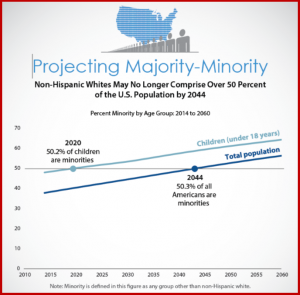
By 2029 one-in-five Americans will be age 65 or older, up from one in seven in 2014.
A new U.S. Census Bureau report released today provides an analysis of the nation’s population looking forward to 2060, including size and composition across age, sex, race, Hispanic origin and nativity. Growth rates are key to economic performance and tax revenues, of course, including the output of the auto industry.
U.S. population is projected to grow more slowly in future decades than it did in the previous century. A total population of 319 million in 2014 is projected to reach the 400 million in 2051 and 417 million in 2060.
Around the time the 2020 Census is conducted, more than half of the nation’s children are expected to be part of a minority race or ethnic group. This proportion is expected to continue to grow so that by 2060, just 36% of all children (people under age 18) will be single-race non-Hispanic white, compared with 52% today.
The U.S. population as a whole is expected to follow a similar trend, becoming majority-minority in 2044. The minority population is projected to rise to 56% of the total in 2060, compared with 38% in 2014.
Another milestone will be achieved by the 2030 Census. All baby boomers will have reached age 65 or older (this will actually occur in 2029). Consequently, in that year, one-in-five Americans would be 65 or older, up from one in seven in 2014.

About Ken Zino
Ken Zino, editor and publisher of AutoInformed, is a versatile auto industry participant with global experience spanning decades in print and broadcast journalism, as well as social media. He has automobile testing, marketing, public relations and communications experience. He is past president of The International Motor Press Assn, the Detroit Press Club, founding member and first President of the Automotive Press Assn. He is a member of APA, IMPA and the Midwest Automotive Press Assn.
He also brings an historical perspective while citing their contemporary relevance of the work of legendary auto writers such as Ken Purdy, Jim Dunne or Jerry Flint, or writers such as Red Smith, Mark Twain, Thomas Jefferson – all to bring perspective to a chaotic automotive universe.
Above all, decades after he first drove a car, Zino still revels in the sound of the exhaust as the throttle is blipped during a downshift and the driver’s rush that occurs when the entry, apex and exit points of a turn are smoothly and swiftly crossed. It’s the beginning of a perfect lap.
AutoInformed has an editorial philosophy that loves transportation machines of all kinds while promoting critical thinking about the future use of cars and trucks.
Zino builds AutoInformed from his background in automotive journalism starting at Hearst Publishing in New York City on Motor and MotorTech Magazines and car testing where he reviewed hundreds of vehicles in his decade-long stint as the Detroit Bureau Chief of Road & Track magazine. Zino has also worked in Europe, and Asia – now the largest automotive market in the world with China at its center.


